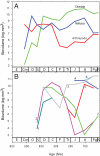Two-phase increase in the maximum size of life over 3.5 billion years reflects biological innovation and environmental opportunity
- PMID: 19106296
- PMCID: PMC2607246
- DOI: 10.1073/pnas.0806314106
Two-phase increase in the maximum size of life over 3.5 billion years reflects biological innovation and environmental opportunity
Abstract
The maximum size of organisms has increased enormously since the initial appearance of life >3.5 billion years ago (Gya), but the pattern and timing of this size increase is poorly known. Consequently, controls underlying the size spectrum of the global biota have been difficult to evaluate. Our period-level compilation of the largest known fossil organisms demonstrates that maximum size increased by 16 orders of magnitude since life first appeared in the fossil record. The great majority of the increase is accounted for by 2 discrete steps of approximately equal magnitude: the first in the middle of the Paleoproterozoic Era (approximately 1.9 Gya) and the second during the late Neoproterozoic and early Paleozoic eras (0.6-0.45 Gya). Each size step required a major innovation in organismal complexity--first the eukaryotic cell and later eukaryotic multicellularity. These size steps coincide with, or slightly postdate, increases in the concentration of atmospheric oxygen, suggesting latent evolutionary potential was realized soon after environmental limitations were removed.
Conflict of interest statement
The authors declare no conflict of interest.
Figures


References
-
- Alroy J. Cope's rule and the dynamics of body mass evolution in North American fossil mammals. Science. 1998;280:731–734. - PubMed
-
- Jablonski D. Body-size evolution in Cretaceous molluscs and the status of Cope's rule. Nature. 1997;385:250–252.
-
- Smith FA, et al. Similarity of mammalian body size across the taxonomic hierarchy and across space and time. Am Nat. 2004;163:672–691. - PubMed
-
- Brown JH, Nicoletto PF. Spatial scaling of species composition —Body masses of North American land mammals. Am Nat. 1991;138:1478–1512.
Publication types
MeSH terms
Substances
LinkOut - more resources
Full Text Sources
Other Literature Sources

